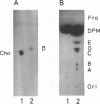Abstract
Pseudomonas sp. strain ST-200, which is capable of conversion of cholesterol, was isolated from humus soil. This organism effectively modified cholesterol dissolved in an organic solvent by dehydrogenation and oxygenation. When the organism was grown in a medium overlaid with a 10% volume of a mixed organic solvent (p-xylene and diphenylmethane; 3:7, vol/vol) containing cholesterol (20 mg/ml), the cholesterol concentration in the organic solvent was reduced to only 0.4 mg/ml after 8 days. Although the organism did not assimilate cholesterol, 98% of the cholesterol initially present disappeared. The organic solvent layer contained two major and three minor compounds converted from cholesterol. The major compounds were 6β-hydroxycholest-4-en-3-one (8.9 mg/ml) and cholest-4-ene-3,6-dione (7.6 mg/ml). The concentrations of these compounds were equivalent to 43 and 37% of the cholesterol initially present. This organism would provide an effective and convenient system to oxidize the C-3 and -6 positions of cholesterol by introduction of a hydroxyl or ketone group.
Full text
PDF





Images in this article
Selected References
These references are in PubMed. This may not be the complete list of references from this article.
- COURCHAINE A. J., MILLER W. H., STEIN D. B., Jr Rapid semi-micro procedure for estimating free and total cholesterol. Clin Chem. 1959 Dec;5:609–614. [PubMed] [Google Scholar]
- Cruden D. L., Wolfram J. H., Rogers R. D., Gibson D. T. Physiological properties of a Pseudomonas strain which grows with p-xylene in a two-phase (organic-aqueous) medium. Appl Environ Microbiol. 1992 Sep;58(9):2723–2729. doi: 10.1128/aem.58.9.2723-2729.1992. [DOI] [PMC free article] [PubMed] [Google Scholar]
- Favre-Bulle O., Schouten T., Kingma J., Witholt B. Bioconversion of n-octane to octanoic acid by a recombinant Escherichia coli cultured in a two-liquid phase bioreactor. Biotechnology (N Y) 1991 Apr;9(4):367–371. doi: 10.1038/nbt0491-367. [DOI] [PubMed] [Google Scholar]
- HUGH R., LEIFSON E. The taxonomic significance of fermentative versus oxidative metabolism of carbohydrates by various gram negative bacteria. J Bacteriol. 1953 Jul;66(1):24–26. doi: 10.1128/jb.66.1.24-26.1953. [DOI] [PMC free article] [PubMed] [Google Scholar]
- Hustedt H., Kroner K. H., Stach W., Kula M. R. Procedure for the simultaneous large-scale isolation of pullulanase and 1,4-alpha-glucan phosphorylase from Klebsiella pneumoniae involving liquid-liquid separations. Biotechnol Bioeng. 1978 Dec;20(12):1989–2005. doi: 10.1002/bit.260201212. [DOI] [PubMed] [Google Scholar]
- Schwartz R. D., McCoy C. J. Epoxidation of 1,7-octadiene by Pseudomonas oleovorans: fermentation in the presence of cyclohexane. Appl Environ Microbiol. 1977 Jul;34(1):47–49. doi: 10.1128/aem.34.1.47-49.1977. [DOI] [PMC free article] [PubMed] [Google Scholar]
- Stanier R. Y., Palleroni N. J., Doudoroff M. The aerobic pseudomonads: a taxonomic study. J Gen Microbiol. 1966 May;43(2):159–271. doi: 10.1099/00221287-43-2-159. [DOI] [PubMed] [Google Scholar]



